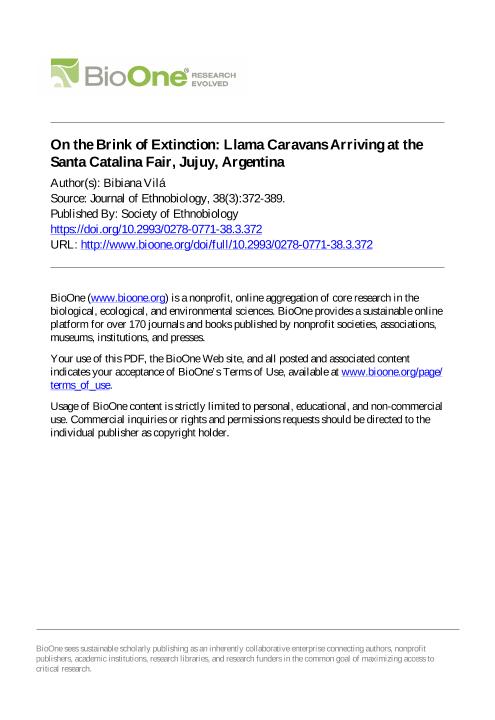Artículo
On the Brink of Extinction: Llama Caravans Arriving at the Santa Catalina Fair, Jujuy, Argentina
Fecha de publicación:
09/2018
Editorial:
Society of Ethnobiology
Revista:
Journal of Ethnobiology
ISSN:
0278-0771
Idioma:
Inglés
Tipo de recurso:
Artículo publicado
Clasificación temática:
Resumen
The practice of using llama (Lama glama) caravans has decreased in Jujuy, northwestern Argentina, in recent years. Peasants, in this area known as pastores, llameros, or caravaneros, belong to Andean indigenous communities in Nor Lipez, Bolivia. The llameros, with their caravans, travel essentially to barter llama fiber in exchange for industrial food-products, mainly flour and sugar. The caravan trip to and from Santa Catalina takes an average of 12 days, five days going to and from the fair, and two days camping at the fair itself. These llameros belong to extended families that include young boys and women. Llameros have their own ethnotaxonomy and can recognize each animal of the troop. Today's llama caravans are pre-Hispanic in origin, thereby presenting collective continuance with the past. Yet caravans are disappearing given the ever more ubiquitous presence of vehicles, a trend that is also seen in other regions of the world. This paper presents a systematic study of the factors relating to the decline in the use of caravans in northwestern Argentina based on data collected from 2013 to 2017. Three reasons are offered (two socioeconomic and one environmental) to explain the observed decline: (a) the presence of a growing textile industry in Bolivia, with an increase in the demand for camelid fiber; (b) the improvement in living conditions in Bolivia; and (c) the drought that affected the area, with very little pasture for the animals on their route.
Palabras clave:
ANDEAN FAIR
,
CARAVANS
,
LLAMAS
,
SANTA CATALINA
Archivos asociados
Licencia
Identificadores
Colecciones
Articulos(SEDE CENTRAL)
Articulos de SEDE CENTRAL
Articulos de SEDE CENTRAL
Citación
Vila, Bibiana Leonor; On the Brink of Extinction: Llama Caravans Arriving at the Santa Catalina Fair, Jujuy, Argentina; Society of Ethnobiology; Journal of Ethnobiology; 38; 3; 9-2018; 372-389
Compartir
Altmétricas




